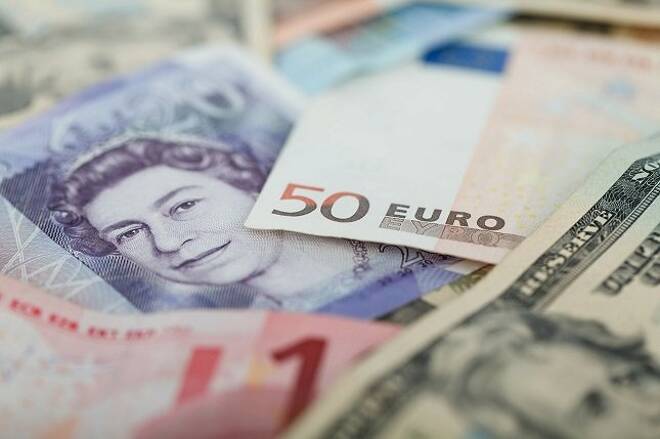Advertisement
Advertisement
EUR/USD Daily Technical Analysis for June 9, 2017
By:
The EUR/USD moved lower following the ECB’s decision to leave interest rates unchanged and drop their easing bias, taking up a neutral stance on how they
The EUR/USD moved lower following the ECB’s decision to leave interest rates unchanged and drop their easing bias, taking up a neutral stance on how they will view monetary policy. The quantitative easing schedule was unchanged and said rates will remain at current levels”, rather than “current or lower levels”, according to the transcripts.
Technicals
The EUR/USD edged through support near the 10-day moving average at 1.1220, which is now seen as short term resistance. Additional resistance is seen near the weekly highs at 1.1285. Support is seen near and upward sloping trend line seen near 1.1140. Momentum has turned negative as the MACD (moving average convergence divergence) generated a crossover sell signal. This occurs as the spread (the 12-day moving average minus the 26-day moving average) crosses below the 9-day moving average of the spread. The index moved from positive to negative territory confirming the sell signal.
The ECB Keeps QE in Place
The central bank maintains that it has the flexibility to alter the QE program “in terms of size and/or duration”, if the outlook becomes less favorable. The announcement follows as better than expected upward revision to EU, Q1 GDP. Eurozone Q1 GDP revised up to 0.6% quarter over quarter, from 0.5% quarter over quarter, as expected after the upward revisions to French, Italian and Greek numbers.
No Timing of Tapering
ECB didn’t discuss timing of tapering decision. Asked whether markets are right to expect a September announcement on tapering and the future of the QE program next year in September Draghi said the issue wasn’t discussed. We don’t think that there will already be an announcement in September, and expect the central bank to continue to inch towards exit steps. So far, the ECB hasn’t even removed the easing bias full yet, as asset purchases could still be extended, even a move to a tightening bias in September would already be a big step, and details on tapering may have to wait until December. Fundamentally low the ECB is still likely to start tapering early in 2018, but Draghi clearly doesn’t want to commit or get markets scared too early, so the central bank will continue to inch its way towards exit steps.
The ECB Lifts Growth Forecasts
ECB lifts growth forecast by 0.1% points through 2019. The new ECB staff projections see growth at 1.9% this year, followed by 1.8% in 2018 and 1.7% in 2019, this is an upward projection of 0.1% points throughout the forecast horizon. At the same time, the inflation projections were cut more markedly – to 1.5% this year from 1.7%, while the forecasts for 2018 and 2019 are now at 1.3% and 1.6% respectively, down from 1.6% and 1.7% previously. As expected lower oil prices were the main reasons behind the downward revisions
German April IP Rose
German April industrial production rose 0.8% month over month, more than expected and with March revised up to -0.1% month over month from -0.4% month over month reported initially. Production was mainly boosted by energy, which rebounded 5.7% month over month, after a slump of -4.3% in March, as a late spell of cold weather hit the country in April. Similarly, to orders data yesterday, the annual rate improved marginally and now stands at 2.8% year over year, up from 2.2% year over year in the previous month. Manufacturing was up 0.4% month over month and 2.1% year over year and together with robust survey numbers the data still sees the recovery intact and Germany heading for solid growth in Q2.
Swiss May CPI Was Warmer than Expected
Swiss May CPI data came in a little warmer than expected, lifting to 0.5% year over year from 0.4% year over year in April. The median forecast had been for an unchanged 0.4% rate. CPI still remains below the cycle high 0.6% rate, which was recorded in both February and March. SNB president Jordan last week reaffirmed that central bank’s commitment to easy monetary policy settings, which are aimed at keeping a cap on the Swiss franc, and which he continued to describe as being “significantly overvalued.”
U.S. Consumer Credit Rose in April
U.S. consumer credit rose only $8.2 billion in April, half of March’s $19.5 billion jump which was revised from $16.4 billion. The strength remained in the nonrevolving credit series, where the figure increased $6.7 billion after rising $14.1 billion previously which was revised from $14.5 billion. Revolving credit edged up $1.5 billion following March’s $1.7 billion which was revised from $2.0 billion.
About the Author
David Beckerauthor
David Becker focuses his attention on various consulting and portfolio management activities at Fortuity LLC, where he currently provides oversight for a multimillion-dollar portfolio consisting of commodities, debt, equities, real estate, and more.
Advertisement
